I can’t quite believe I just glanced down to check the date on the computer. Boxing day, Christmas all over for another year. I was thinking of doing a retrospective six but I’ve never felt less like looking backwards. In the moment then, happening now; meagre pickings on that front too. Not too meagre if you get in close with the camera.
On Christmas morning I was taking stacked images of camellia foliage to put in the National Collection records (doesn’t everyone?) and thought while I had the camera set up I’d picture this iris. It didn’t come out as I’d envisaged but you get the general idea. I went to an HPS talk by the man from Jacques Amand Intl., which inspired me to get a few different Iris reticulata varieties. This one is ‘North Star’, it’s very pretty and it has a rather good scent as well. The colour isn’t quite right but I’m not going to try and correct it from memory.
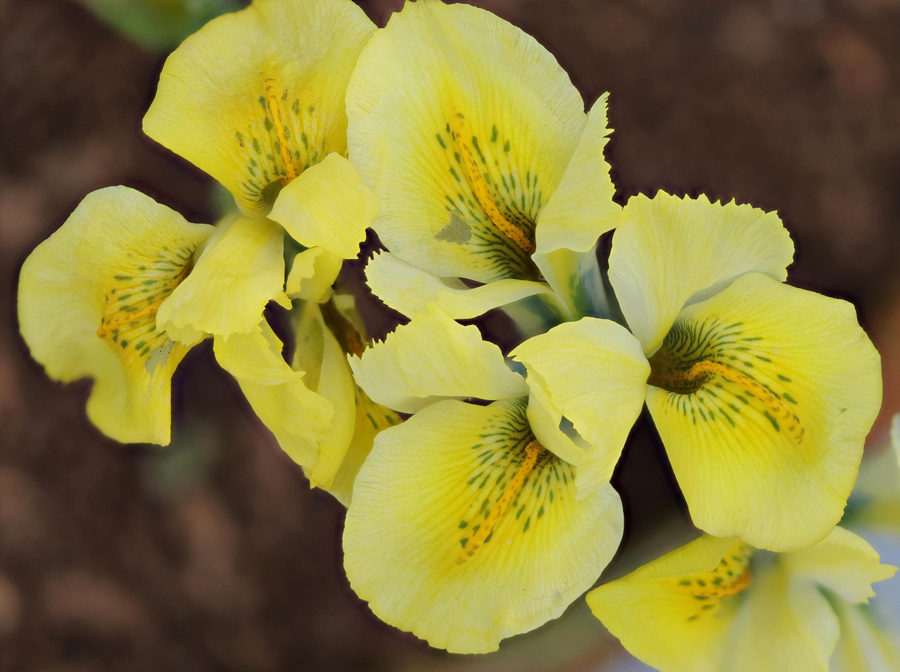
I noticed that the Camellia lutchuensis that I’d bought a bit back had opened its first flower, so I took its picture too. This is a species that is being used a lot to breed both scent and resistance to flower blight into camellias. It’s not very hardy, would probably just survive outside here; it has small white flowers with a lovely scent.
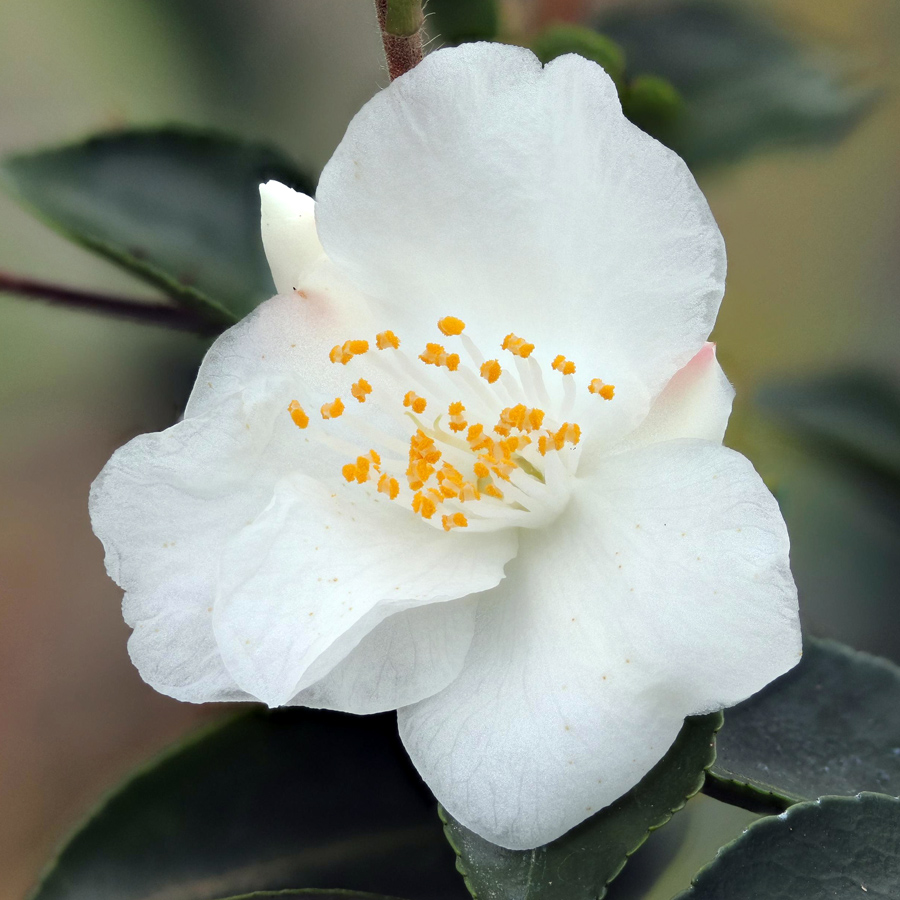
Out in the garden there is a serious shortage of things happening. This group of Cyclamen coum have settled in well. I planted several plants over a couple of years and they are seeding about quite enthusiastically.

I’ve had odds and ends of primroses flowering for some time, usually rather moth eaten, so held in reserve till now. Common primrose. You wouldn’t immediately think they were related to Cyclamen, but both are in Primulaceae. Serious contender for my favourite native wildflower.
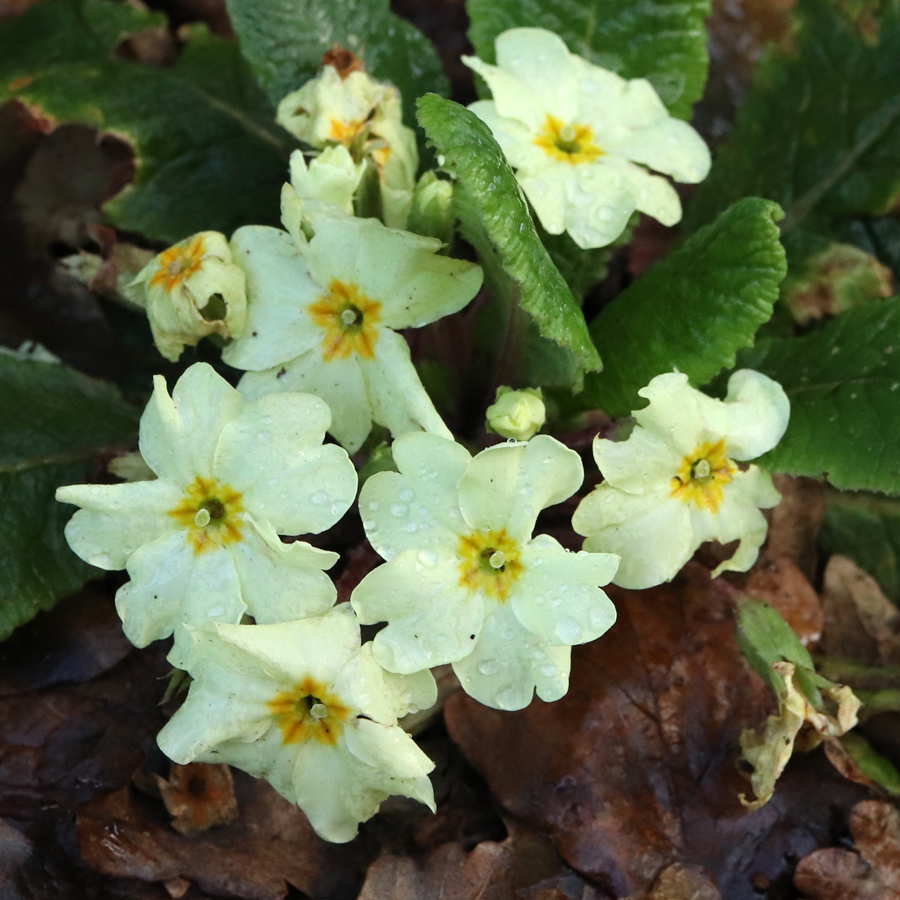
The sun showed its face briefly, lighting up the yellow stems of my bamboo. It’s going to get a beating tonight, as storm Bella sweeps through. I should have thinned it out even more than I did, reduce its wind resistance some more.
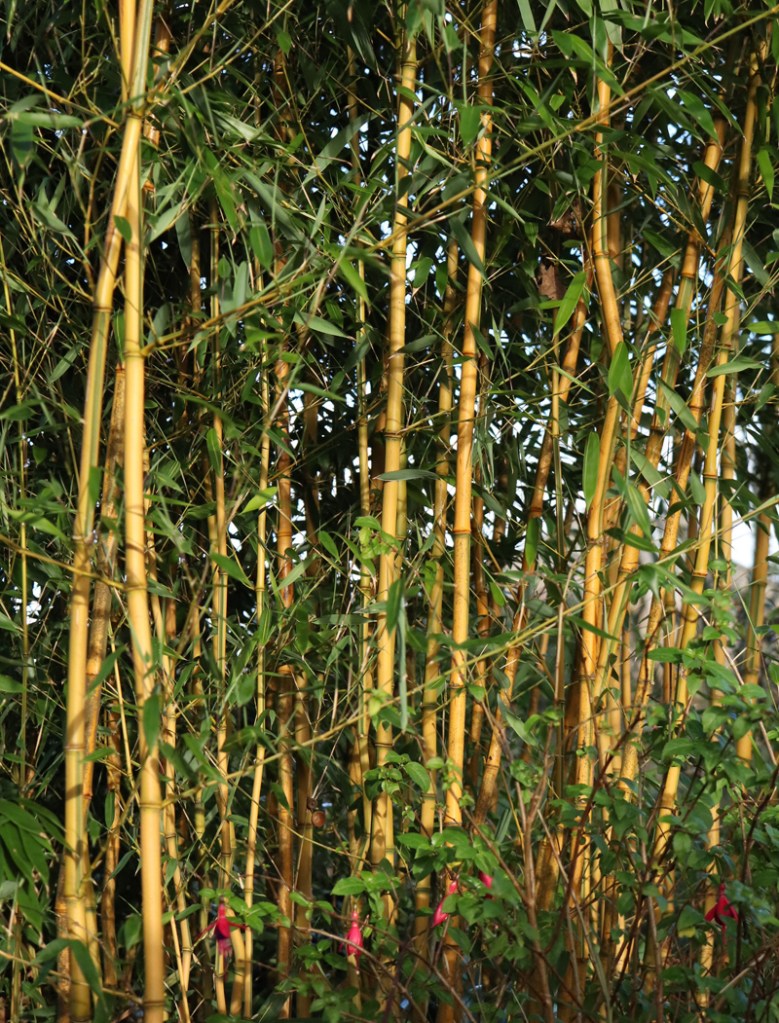
Back indoors for the next shot, though the plant itself is outside. Camellia sasanqua ‘Navajo’ through the front window; having a rather good fresh flush of blooms. They’re smaller and paler than the earlier ones but I really am not complaining. There’ll not be much left of it tomorrow either.
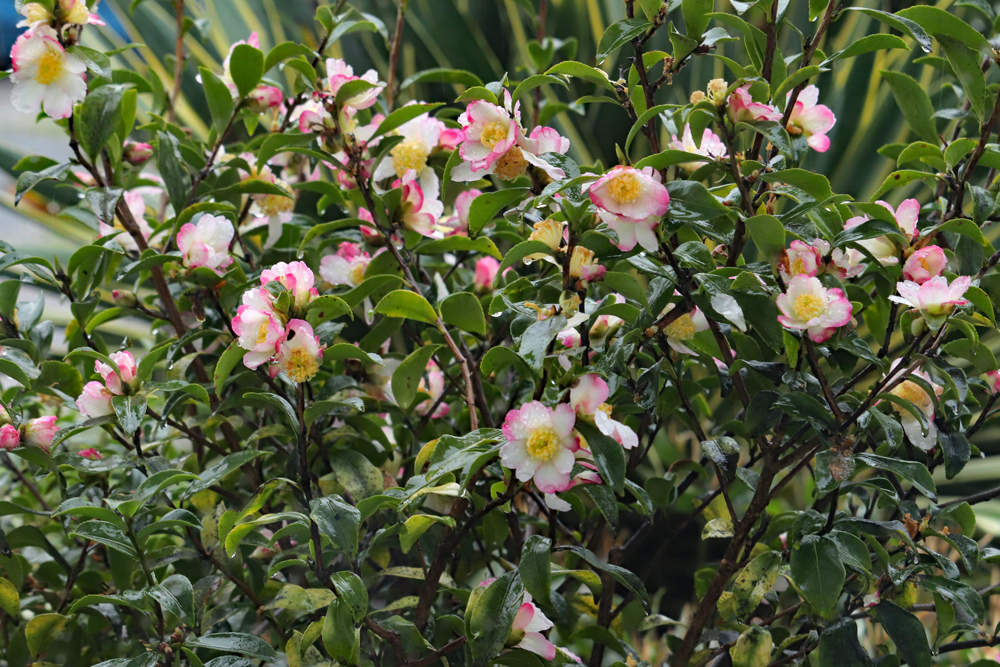
Sitting inside and looking at the garden through the window may be as near to gardening as you can get so I’m going to give away a part of myself with a few links to things on YouTube that I’ve been known to listen to while looking at flowery things on the computer. Another six in fact, meaning I’ve left out both Tom Waits and the Tiger Lillies. Consider them a post Christmas bonus.
The Lakes of Pontchartrain” – Aoife O’Donovan
Largo (Improvisation on the Theme of the “Ombra mai fu” Aria from Act 1 of Handel’s “Serse”,… – YouTube
Sheku Kanneh-Mason – No Woman, No Cry (Arr. Cello) [Studio Session] – YouTube
Blackberry Winter (Take 9) – YouTube
Yo-Yo Ma plays Appalachia Waltz – YouTube
Vladimir Horowitz – Träumerei – Schumann (Kinderszenen) – YouTub
Here and Heaven (featuring Aoife O’Donovan) (In-Studio Video) – YouTube
Oops, can’t count. Don’t suppose anyone will notice. The Sechsmeister won’t, I’m sure, bigger fish to fry. Happy New Year folks.
Dear Jim
Thoroughly enjoyed all of your posts read since I was told about your site, and look forward to it every saturday.
By the way, we have 2 mature Camellia Lutchuensis growing well here in West Sussex, and we do not protect them in any way.
LikeLike
I’m delighted that you enjoy my posts, are you not tempted to join in the fun? That’s good news about lutchuensis; I don’t have room for it in the garden at the moment so it will have to stay in a pot until I get fed up with something else.
LikeLike
Camellia leaves does sound like an unusual assignment. Cyclamen never look better than in a cluster under a tree.
LikeLike
Camellia leaves can be the key to identifying varieties with very similar flowers. So true about cyclamen, they’ll even happily grow close to conifers where nothing else would live.
LikeLiked by 1 person
I’m not sure I understand the technical aspects of photo stacking but the results look really good. Super iris without any slug damage. The Cyclamen coum have a nice mixture of colours, not just the pink ones. My cyclamen seem to have dwindled rather than spread and I’m assuming the squirrels are to blame. I’ve grown on a few more to try in a different spot. Happy New Year.
LikeLike
Every year when cyclamen are in the garden centres I’m on the prowl for different ones, not fancy named ones, just interesting seedlings. We don’t get squirrels I’m pleased to say. I picked a slug off the iris, seemingly before he’d done much.
LikeLike
The cyclamen are so pretty. How nice to have so many flowers of different kinds in late December.
LikeLike
Rather fewer things in flower this year than some, I’ve had to cut down Fuchsias because of gall mite and they’re usually quite good. I’m grateful for anything at this time of the year, this year especially.
LikeLike
The Sasanqua camellias seem to be doing very well for you while we would always have regarded them as borderline tender here in south east Ireland.
That’s a very attractive iris and I’ve been keeping an eye on I. ‘Katherine Hodgkins’ in the garden which is in bud at the moment.
LikeLike
The autumn flowering camellias that Dr Ackerman bred for the colder parts of America would certainly be hardy in Ireland, things like ‘Winter’s Joy’ and ‘Snow Flurry’. The main problem is they need a long season to make growth, ripen the wood and set buds. Mine are in full sun in front of a south facing wall, not the conditions most books recommend for any Camellias.
LikeLiked by 1 person
Yes, I see recent planting at Mount Congreve using this sunny position also – trained against a high wall in the walled garden
LikeLike
So long as they don’t get too dry they’re far happier in sun.
LikeLiked by 1 person
What pretty Irises ! It’s rare to see them so early in December.
While you were taking stacked photos of your camellia, I myself did the same thing but with some of my orchids. The result is always fantastic
Remind me of your bamboo variety?
LikeLike
Glad I’m not the only one putting Christmas Day to good use. Phyllostachys aureosulcata ‘Spectabilis’. Orchid pictures on Twitter?
LikeLiked by 1 person
Yes : https://twitter.com/frdvil/status/1341720071706714118?s=21 and this one 2 months ago https://twitter.com/frdvil/status/1323181485101322259?s=21 ( if you can open the links )
Thanks for the bamboo.
LikeLike
I’ve seen the orchid pics, very nice.
LikeLiked by 1 person
Wow to the photo of the iris. Stunning.
LikeLike
And scented too, I shall be coming back for more.
LikeLiked by 1 person
What a variety of colour in midwinter. I had not realised primroses and cyclamen are related, interesting. Wishing you both a good, safe New Year.
LikeLike
Some very good things in Primulaceae; Androsace, Dionysia, Dodecatheon, Soldanella; I’ve killed dozens of them.
LikeLike
Very pretty iris. Added a few different Iris reticulata for next year. Mainly purple varieties. The cyclamen doing well. I’ve added a few more coum this year as the couple I have aren’t spreading at any great pace but probably leave them to spread naturally now.
LikeLike
I was encouraged by an Iris reticulata flowering last year that I’d long since forgotten planting. I collected seed of C. coum and hederifolium to sow in pots, which was almost too successful, I have hundreds to plant, a very nice problem to have.
LikeLike
Camellias are of course both beautiful, but Navajo calls to me just a little bit louder. Loving the play list, will listen later, but slightly disappointed that you left out Tom Waits, which song would you have included?
LikeLike
Seasonal sentimentality may have a hand here, but Kentucky Avenue and House Where Nobody Lives for starters. (Tiger Lillies Hampsters, I see even YouTube has a warning on it!)
LikeLike
*gulp* good ones, but Waltzing Matilda was my first and still most favourite. Glad to meet another TM fan. As for Tiger Lilies, don’t know them, will have to check them out.
LikeLike
I think Waltzing Matilda was my introduction to TW too. So many great songs. I will say nothing about Tiger Lillies except that ‘Farmyard Filth’ was my introduction to them. You won’t want kids, or your mother, in the room.
LikeLike
🤣
LikeLiked by 1 person
Are there cultivars of Camellia lutchuensis. The name sounds familiar as if we used to grow it. All of our camellias were garden varieties. Most were Camellia japonica. Some were Camellia sasanqua. A few were Camellia reticulata. We grew only a few of anything else, and only for the Camellia Society, rather than for our regular clients. We grew a few bamboos too, which did not go well at all. We were not set up for it, and were then unable to sell what we grew.
LikeLike
I’m not aware of any cultivars of C. lutchuensis but it has been used a lot to hybridise with other species, notably japonica. When I say other species I mean cultivars of other species, like japonica, most of which are probably hybrids anyway.
LikeLiked by 1 person
I knew almost all of our Camellia japonica as such, whether or not they were pure bred. Those that ‘look’ like Camellia japonica get that designation. The only exceptions were those that were direct hybrids of Camellia japonica and Camellia sasanqua. They bloomed very profusely, but the bloom did not last. Now it will make me wonder where I know the name of Camellia lutchuensis from.
LikeLike
Did you have ‘Cinnamon Cindy’, one of William Ackerman’s crosses using lutchuensis. I think most have come from Japan or New Zealand.
LikeLiked by 1 person
That one does not sound familiar. Is it related to Peppermint Patty?
LikeLike
They were both raised by Ackerman, ‘Cinnamon Cindy’ is C.japonica ‘Ken’yôtai’ x C. lutchuensis, ‘Peppermint Patty’ is C. japonica ‘Osaruku’ x ‘White Butterfly’.
LikeLiked by 1 person
WHAT?! I was being sarcastic. I was not aware of ‘Peppermint Patty’.
So then, ‘Peppermint Patty’ is a full on Camellia japonica, not a hybrid.
LikeLike
There are worse people to be on the same wavelength as than William Ackerman. ‘Peppermint Patty’ doesn’t get a mention in his book ‘Beyond the Camellia Belt’ and neither do either of its parents, which I find slightly surprising. ‘White Butterfly’ is a name for two cultivars, a japonica and a sasanqua; the Camellia register gives ‘Peppermint Patty’ as a japonica which means it should have been the japonica version but Ackerman was doing more with sasanquas than japonicas so who knows? As to C. japonica, I think the prevailing view is that such is the diversity amongst its purported cultivars that there are almost certainly other species in its heritage. The same is true of sasanqua, with most cultivars being a world apart from the wild species, which is generally very uniform.
LikeLiked by 1 person
DNA research may eventually clarify some of it, . . . which, in a way, takes some of the fun out of it. If I were to do breeding, I would maintain meticulous records. However, I also know that some of my favorites appear where neither planned nor expected. ‘Life (like gardening) is what happens while we are busy making plans.’
LikeLike
I don’t know what the ratio of controlled crosses to happy accidents is in Nuccio’s catalogue, I seem to think most were left to natures whim. Such DNA analysis as I’m aware of with camellias, excepting tea varieties, hasn’t helped at all, confused things still further if anything. When you see how little it takes to switch from a white flower, through striped to red, then back again; what are you looking for? One millionth of the genome changed maybe? Not even changed in structure, merely its position on the chromosome?
And then I googled the quote from Allen Saunders, who I’d never heard of but who has his own Wikipedia page. I was looking at a website which had complete genomes for various plants on it the other day. Too much knowledge, way too little time to even find it, let alone understand it, far less use it.
LikeLiked by 1 person
It is probably best to enjoy the cultivars for what they are.
LikeLiked by 1 person
Happy Boxing Day Jim. You are well ahead in the Iris department, with a certain beauty. Are they in the ground or in a pot? Do most gardeners grow these in the same way as the large tulips, ie discard after flowering? I am one of those that like to keep plants. I would love to learn more about how to take them through to good flowering the following year, and you have prompted my homework for this week.
LikeLike
I put them, and a couple of other varieties, in pots, because I thought they’d be easier to keep track of. If you find the answers to keeping them flowering let me know. I suspect it’s in the nature of flowering sized corms to die leaving lots of small ones to grow on. The Dutch grow vast quantities, take the flowering sized corms to sell and replant the rest to grow on. At least I think that’s how it works, the speaker did tell us but I’ve already forgotten.
LikeLike